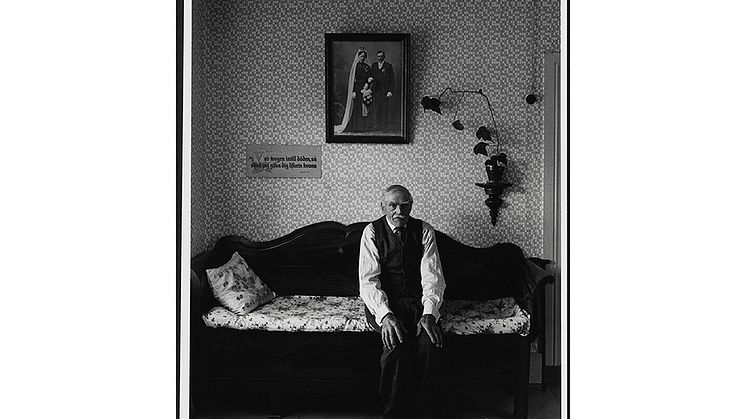
Press release -
New Acquisition: Portrait of retired farmer P.A. Söderström, by Sune Jonsson
The National Museum has acquired a portrait of P.A. Söderström, a retired farmer. It was taken in 1962 by the photographer Sune Jonsson. It was included in the book Images of the Children of Grace. The portrait is an interesting example of Jonsson's documentary photography, and is also one of the few representations of a small farmer in Sweden’s National Portrait Gallery.
The retired farmer Per Albin Söderström (1883-1969) sits on a sofa in his home in Ytterbyn (Lövånger Parish). He is dapperly dressed in a white shirt, vest and tie. Perhaps the picture was taken on a Sunday, or maybe Söderström wished to dress up for the photographer. The sofa is made up with a covered down blanket and a comfortable pillow, so that the old man can rest there. On the wall hangs a framed photograph of a bride and groom from the turn of the last century. Both are solemnly dressed in black. Next to them there is a painting with a Bible saying: “Be thou faithful unto death and I will give thee the crown of life.” (Revelation 2:10).
Söderström’s portrait was included in Sune Jonsson's book Images of the Children of Grace: An Environmental Study (1963). In it, he depicts Rosenian Pietists in words and pictures. They were followers of a movement within the Evangelic Patriotic Foundation, the name of which was derived from that of its founder, the revival preacher Carl Olof Rosenius (1816-1868). The movement gained its firmest foothold in Västerbotten, including in Lövånger, where there was a strong tradition of readers who carefully studied both the Bible and edifications. The book’s text describes the movement and its history. Jonsson designates the illustrations as “The Environments”. They comprise both portraits of the Children of Grace and interiors and still lifes from their homes.
In addition to being a depiction of a single individual in a Västerbotten village, the dignified portrait of P.A. Söderström also represents the small farm culture and environments that could once be found all over Sweden. This smallholder and his contemporaries belonged to the last generations of such farmers. Jonsson's portrait plays a crucial role in the documentation of these people, who have long since vanished. They are always depicted in their own environment and are portrayed with great respect. The photographs have an objective and documentary character, devoid of nostalgia.
At an exhibition of his work at Moderna Museet in 1962, the photographer Sune Jonsson (1930-2009) stated that he wrote and photographed in order to “recount, enrich and preserve” – words to which he remained faithful throughout his career. He worked primarily as a documentary photographer, and toward the end of the 1960s he began working as a field ethnologist for Västerbotten Museum. In addition to photography, he devoted himself to writing (both fiction and non-fiction) and film. In addition, he endeavoured to collect and preserve the work of other photographers. Today, Västerbotten Museum is home to the Sune Jonsson Centre for Documentary Photography.
In 1993, Jonsson wrote that “we must thwart the plans of time and save threatened environments, people and phenomena, so that in the future we can at least meet them in documentary photographs”. In this portrait, we can meet P.A. Söderström from Ytterbyn, a small farmer, who has now become part of the National Portrait Gallery.
The acquisition of Sune Jonsson's portrait of P.A. S have been made possible by donations from the Gripsholm Association. Nationalmuseum receives no state funds with which to acquire artwork and handicrafts; its collections are enriched through donations and funds from private foundations and trusts.
Inventory number: NMGrh 5162
More information:
Mattias Robertson, Press Officer, press@nationalmuseum.se, +46 767 23 46 32
Eva-Lena Karlsson, Curator, eva-lena.karlsson@nationalmuseum.se, +46 8 519 544 30
Categories
Nationalmuseum is Sweden’s museum of art and design. The collections comprise older paintings, sculpture, drawings and graphic art, and applied art and design up to the present day. The museum building is currently under renovation and scheduled to open again October 13, 2018. In the meantime, the museum will continue its activities through collaborations both in Sweden and abroad. Nationalmuseum has partnerships with Svenska Dagbladet and the Grand Hôtel Stockholm.

